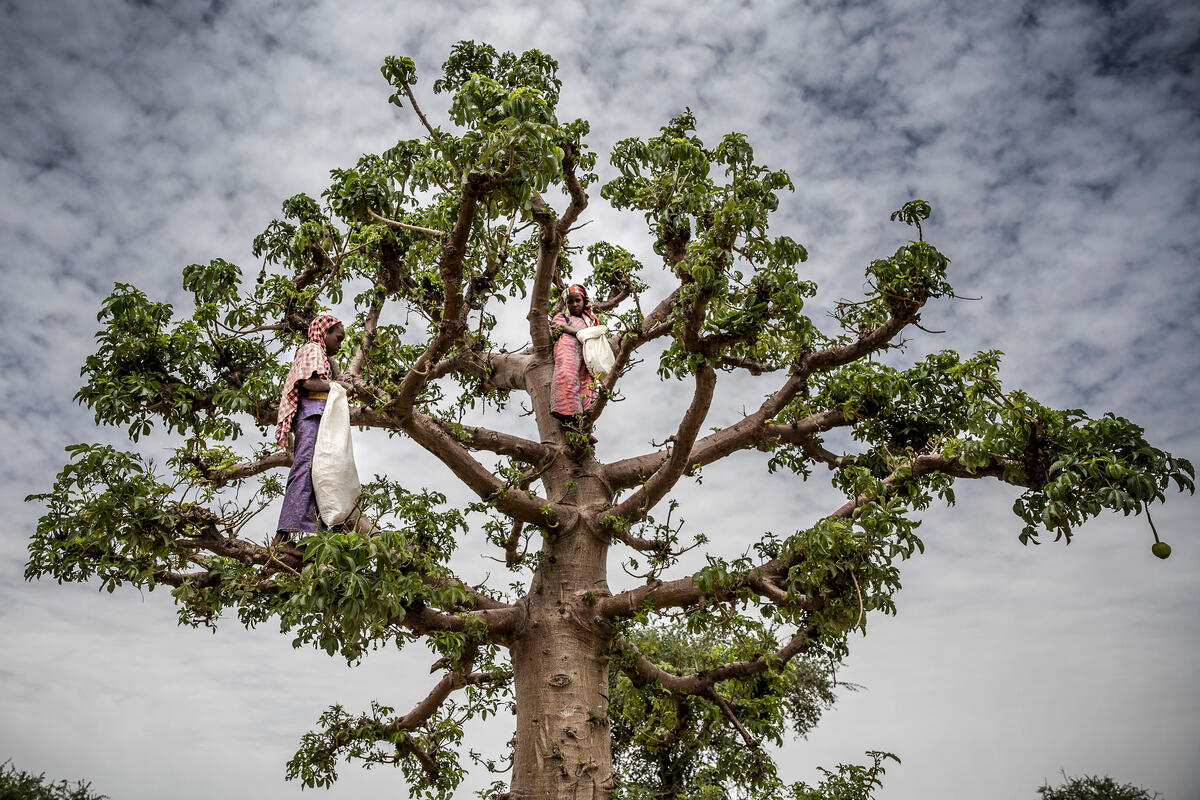Seven vital ecosystem services plants provide
In the dry Sahel, two girls perch high in the branches of a baobab tree, her sack in hand as she harvests its leaves to be cooked as a meal. The baobab’s trunk stores precious water through long dry seasons, its broad canopy casts much-needed shade over the livestock grazing below while nitrogen-fixing shrubs at its roots help bind and enrich the soil.
Across the world, billions depend on these invisible benefits - known as ecosystem services that plants provide - yet rarely recognize them as the life-support networks they are. When plant health is threatened, these services collapse, putting human, animal, and environmental health at risk.
Here are seven vital ecosystem services plants provide that are worth protecting.

Plants purify the air
Through photosynthesis, plants produce 80 percent of the oxygen we breathe - a service that makes life on Earth possible. Terrestrial plants like trees, grasses, and crops play a major role in this, forming the green lungs of our continents. But microscopic organisms called phytoplankton, which drift near the surface of oceans and freshwater bodies, also carry out photosynthesis. This diverse group includes green algae, which are true plants, along with other organisms. In addition, vegetation functions as a vast, living air-filtration network. Leaves and bark absorb pollutants such as nitrogen dioxide, sulphur dioxide, and fine particulate matter, trapping and storing (or sequestering) these harmful substances to improve air quality. In the eastern Mediterranean region, air pollution contributes to around 400 000 premature deaths annually according to the World Health Organization, a toll that urban and peri-urban green spaces can help mitigate. In other regions of the world, the loss of millions of ash trees to the emerald ash borer (Agrilus planipennis) - an invasive plant pest - has been linked to over 6 000 additional respiratory and 15 000 cardiovascular deaths in affected areas - underscoring how plant pests can impact human health.
Plants moderate temperatures and shield cities
Through shading and the process of transpiration - where plants release water vapor from their leaves into the air, cooling their surroundings - plants and urban trees lower temperatures and help reduce the urban heat island effect - where cities become much hotter than nearby rural areas. Heatwaves are now among one of the deadliest climate hazards. When the devastating bacterial pathogen Xylella fastidiosa killed millions of olive trees in Italy, the loss of tree cover meant less shade and cooling for the land. This made local areas hotter, dried out the soil faster, and disrupted the delicate balance of the local climate, making it harder for both people and nature to cope with rising temperatures.

Plants provide food, feed, fuel and fibre
Healthy plants underpin our most fundamental resources. For food security, the nineteenth-century potato late blight (Phytophthora infestans) demonstrated how a single pathogen can induce famine when it ravages a staple crop. Animal feed is equally vulnerable – swarms of desert locusts can strip millions of hectares of pasture in days, leaving livestock without forage and threatening rural livelihoods. North America’s mountain pine beetle (Dendroctonus ponderosae) outbreak killed vast pine forests, reducing both firewood supplies and biomass for energy. And in the realm of fibre, the cotton bollworm (Helicoverpa armigera) gnaws through developing bolls, inflicting significant economic losses on the global cotton industry each year. Protecting plant health helps safeguard food security and nutrition, energy sources, and economic stability.
Plants help control erosion, enrich soils, and protect clean water supplies
Plant roots hold the soil together, helping to stop rainwater from washing it away. Some plants can also enrich the soil. For example, bacteria in the root nodules of legumes can convert atmospheric nitrogen into nutrients plants can use, reducing the need for synthetic fertilizers.
At the same time, vegetation acts like a natural filter, trapping pollutants before they can flow into rivers, lakes, or underground water supplies. In deforested regions, loss of plant cover has led to dramatic increases in river sedimentation, degrading drinking-water quality and harming aquatic life. Healthy landscapes rich in plant life act as natural buffers against floods, droughts, and contamination, ensuring reliable water for people, wildlife, and agriculture.

Plants anchor biodiversity
A rich diversity of plant species creates the foundation for entire food webs, offering food and shelter to pollinators, predators, decomposers, and vertebrates. This, in turn, enables natural pest control, seed dispersal, and disease regulation. When ash dieback (Hymenoscyphus fraxineus) impacted heavily Europe’s ash trees, many species, from moths and beetles to lichens and fungi, lost critical habitat. Those gaps in the canopy encouraged invasive grasses and boosted rodent populations, some of which host the tick Ixodes ricinus - a potential vector of Lyme disease in nearby communities.
Plants nourish soils
Plants don’t merely draw nutrients from soil - they build it. Legumes such as lentils, chickpeas, and cowpeas host nitrogen-fixing bacteria in their roots, naturally fertilizing fields and cutting reliance on synthetic inputs. Integrating trees, shrubs, and crops through intercropping and agroforestry can boost yields on degraded lands, while improving soil structure, suppressing plant pests, and conserving water. These regenerative practices lock carbon into the ground and create resilient landscapes that sustain both agriculture and ecosystem health.
Plants provide the genetic diversity that underpins food security and resilience
Plants are living libraries of genetic traits like drought tolerance, pest resistance and nutrient efficiency that plant breeders use to create more resilient crops. Yet our reliance on a narrow genetic base leaves agrifood systems dangerously exposed to threats. For example, the Cavendish banana accounts for roughly half of global banana production and nearly all exports. When Tropical Race 4, a soil-borne strain of Fusarium oxysporum f.sp. cubense, swept through Cavendish monocultures, it highlighted an essential fact - without genetic diversity, a single plant pathogen can jeopardize an entire staple and the food security and livelihoods of millions. While TR4-resistant banana varieties exist, they are not widely adopted for commercial use. Wild crop relatives and traditional varieties harbour the genetic potential we need. By conserving and integrating these diverse gene pools - also known as plant genetic resources for food and agriculture (PGRFA) - we equip ourselves to adapt crops to shifting climates, emerging pests and diseases, and evolving nutritional needs.
